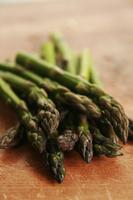
Asparagus (Asparagus officinalis) is a perennial vegetable of the Lily family. Of Eurasian origin, asparagus was grown for food and medicinal purposes over 2000 years ago. Some medicinal benefits attributed to asparagus are that, when eaten before dinner, it refreshes and opens the liver, spleen and kidneys and helps those afflicted with the gravel, or who are scorbatic or dropsical. It is also of singular efficacy in disorders of the eyes and is salutory in many disorders of the breast.
The crop spread throughout Europe and later to North America. The spears, cut when 15-18 cm high, are relished as a cooked or raw vegetable. The crop is established from one-year-old crowns (grown from seed in a nursery), set out in spring in a 15 cm deep furrow, and covered with 5 cm of soil. The emerging spears of a newly established field are harvested for about two weeks in the spring of the third year; the full cutting season (6-8 weeks) is achieved the fifth year. An established field can produce for 15-20 years.
After harvest, spears are permitted to grow into ferns (1.5-2.5 m high) for the manufacture of carbohydrates, which are stored in the fleshy roots and used to produce new growth in spring. The fern, killed by frost, is left to trap snow and insulate roots.
Asparagus beetles in eastern Canada and aphids in the Okanagan Valley, BC, are the principal inspect pests. The major disease is Fusarium wilt; asparagus rust is a problem in humid regions of eastern Canada. Asparagus varieties include Mary and Martha Washington, Viking, Beacon, Jersey Centennial and the all-male hybrids Lucullus and Jersey Giant. The main growing areas in Canada are Ontario, approximately1250 ha; Québec, 280 ha; and BC, 90 ha. Approximately 7000 t of asparagus are produced annually.

 Share on Facebook
Share on Facebook Share on X
Share on X Share by Email
Share by Email Share on Google Classroom
Share on Google Classroom



